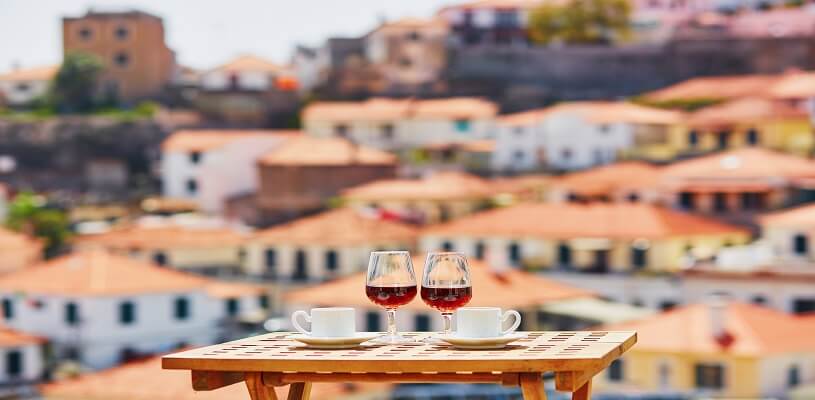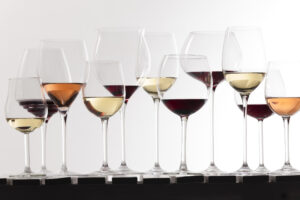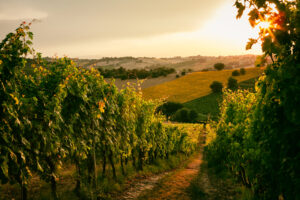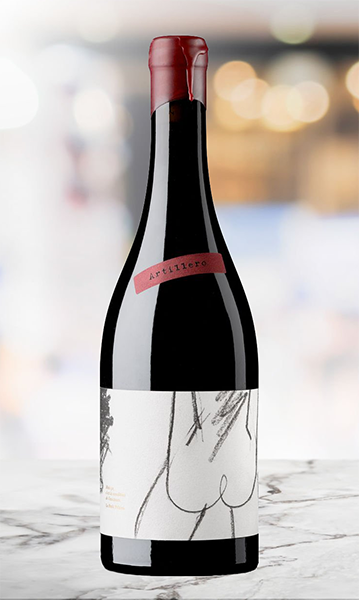- Posted on
- By Cellars Wine Club
- In Wine Life Blog

Picture this. The last rays of the sun hit your face as you sit on the terrace with your close friends. You eat wonderful food and exchange stories from your last trips. There is a sense of tranquility and cheerfulness in the air. And in your glasses, there is the best Portuguese wine brought to you from the most renowned winery.
Sounds like a dream?
If the answer is yes, this guide is for you!
More and more people start their explorations of the wine world, learning about different regions and types, about what makes a good bottle of wine really worth its price, and how to pair different wines with various foods.
The selection of quality wines is bigger and more accessible than ever before. And Portuguese wines are amongst the most interesting and flavorful wines in the whole world. And the best news is that you don’t actually have to spend your whole fortune on a good bottle of Portuguese wine. Especially if you’re traveling through Portugal, you can find some very interesting wines of great quality and very affordable rates.
If you want to become an expert on Portuguese wines, we invite you to read this guide. In it, you will find information about the most prominent Portuguese wine regions, useful wine terms, and some tips on how to differentiate really exquisite bottles from these less awe-inspiring ones.
Grab your passport – we’re going to sunny Portugal!
Portuguese Wine Regions
Unlike many other countries, Portugal has been reluctant to grow and make its wine from foreign grape varieties, which now makes them one of the most interesting destinations when it comes to truly unique and delicious wines.
For the most part, they stick to their indigenous grape varieties, crafting drinks that can compete with the most famous and recognizable brands of wine on the world stage.
Everything begins in sun-soaked Portuguese grape plantations located in different regions of the country. This is where the long history of winemaking and the craftsmanship result in the richness of flavors Portuguese wines are known for.
Here’s what sets apart every wine region of Portugal.
Vinho Verde
You’ve heard about Vinho Verde before? That’s possible since it is both the name of the region located in northern Portugal and the name of the wine type that is made there. Vinho Verde wines are very fresh and crisp, thanks to the specific conditions of this place.
To the north of the region, we have a Minho river, while the south is where the Vouga river has its tracks. Vinho Verde region spreads across the Atlantic coast, and all of this contributes to how fertile this region of Portugal is.
It’s one of the greener parts of the country, where young wines are produced. Actually, Vinho Verde means “green wine,” and it’s a very fitting name since most Vinho Verde wines are released and drunk in the first six months from the harvest.
Young wines like this are very light, with high levels of crisp acidity, very palpable fruit notes, and lower alcohol concentration (around 10%). Most of the Vinho Verde wines are white wines, but you can find some reds and rosé bottles as well.
Common flavor notes
citruses, flowers, apples, peaches, pears, honey
What to pair them with?
seafood, salads, and fish
Best wineries
Soalheiro, Vinhos Norte, Quinta Da Raza
Douro
Douro valley is the most known and oldest wine-making region in Portugal. It’s the home of the Port and Douro regions – both with a great history and cultural significance – that attract thousands of tourists every year. It’s also the place where Port wine was born.
Port wine is a sweet red wine, often served with desserts. There is a considerable number of different varieties of this wine, which presents a great experience for tourists who can always find something for their taste during wine tastings and in local wine shops and wineries.
The whole region is a UNESCO world heritage site. Its green terraced stairsteps have been formed and harvested by hand for thousands of years now, offering breathtaking views and exceptional conditions for growing various grape varieties, like Sezão, Touriga Nacional, or Tinta Cão.
As you can imagine, most varieties of Port wine are made from red grapes, which gives this wine its characteristic pink and red tones. Many of the Port wines will be sweet, but there are more and more dry varieties available.
Common flavor notes
blackberry, plum, raspberry, cinnamon, caramel, fig, rum
What to pair them with?
desserts, dark chocolate, blue cheese, figs
Best wineries
Cálem Wine Cellar, Poças, Quinta Do Vallado

Alentejo
Alentejo, with its hot climate and huge stretches of cork trees, may look surprisingly familiar to Americans – some say it’s quite a Californian-looking region. It’s a massive area covering almost 1/3 of Portugal, which produces some of the best wines this country has to offer.
This region is known for both red wines and white wines, but they excel in full-bodied and fruity reds that are complex and truly unforgettable. Alentejo white wines tend to be a little acidic and delicate. They range from medium-bodied to full-bodied.
Alentejo is where many modern wineries are opening up, offering a big variety of wines made from the best red and white grapes. It’s typical for this region to make exquisite red blends, actually, with the most common ones including Cabernet Sauvignon, Syrah and Alfrocheiro.
Common flavor notes
In whites: citruses, flowers, vanilla, tropical fruits, mineral character
In reds: red fruits, herbs, tobacco
What to pair them with?
Whites: seafood, cheese board, salads
Reds: pork, beef, mushrooms
Best wineries
Enoturismo Cartuxa – Adega Cartuxa, João Portugal Ramos, Ribafreixo Wines
Dão
If you’re looking for higher quality, then you’ll be very happy with Dão wines. Dão region is surrounded by high mountains and pine forests. The higher altitude and soil full of decomposing granite and schist result in quality wines that age very well.
This mountainous region does not get a lot of cold ocean winds, but it’s also not too hot. Dão is known for some of the best Portuguese wines, offering interesting flavor profiles achieved by using grapes with the right balance of maturity and acidity.
You can find there full-bodied reds and interesting white blends. Some people like to compare Dão reds to wines like Pinot Noir, but their flavor profiles are not the same. Still, both types share some similarities when it comes to the quality of the wine.
Common flavor notes
In whites: citruses, green apples, pears, white flower aromas
In reds: raspberries, clove, plums, cherries, vanilla
What to pair them with?
Whites: seafood, chicken, appetizers and snacks, cured meat
Reds: pork, beef, chicken,
Best wineries
Casa de Santar, Quinta Dos Roques, Julia Kemper Wines, Quinta dos Monteirinhos
Lisboa
When you’re looking for very good Portuguese wines that are also very affordable, you should direct your attention toward Lisboa wines. This northern, coastal region of Portugal produces exceptional wines made from crispy, cooled by the ocean’s breeze wine grapes. It’s also one of the most prominent regions in Portugal when it comes to wine export.
This region is where the capital of Portugal is located, so if you are ever in Lisbon, we highly recommend exploring the city’s wine scene. You won’t be disappointed.
Lisboa is a wine region known for producing a big variety of wines, including white, red, and sparkling wines. What is so special about those is that most of the brands available here are very cheap. You can find exquisite wine for as little as $10 to $15 for a bottle.
Common flavor notes
In whites: tropical fruits, coconut, white flowers
In reds: red and black fruits, vanilla, spices, oak
What to pair them with?
Whites: fresh cheese, appetizers, seafood
Reds: pasta, beef, veal
Best wineries
Adega Regional de Colares, Quinta das Carrafouchas, Quinta da Boa Esperança

Beira (Bairrada)
Bairrada is a wine region known for its red Baga grape plantations. It’s a rather small region located by the coast, where in the past it was common to produce 100% Baga red wines. To this day this place is mostly known for its red wine and various sparkling wines.
Baga grapes are characterized by high acidity. They are also pretty tannic, which results in wines that offer their best when they are advanced in age. Although in Beira there is a long tradition of winemaking with only this one variety of grapes, nowadays more and more wine producers mix Baga with different grape varieties to achieve more light-bodied and accessible wines.
There is also an influx of new, modern winemakers in Bairrada, who specialize in making white and sparkling wine that is very fresh, full of the summer sun, and perfect to pair with many Portuguese dishes.
Common flavor notes
In whites: lemons, apple, pear, white flowers, pineapple
In reds: red fruits, smoky notes, herbs
What to pair them with?
Whites: seafood, salads, white meats, cheeses
Reds: red meat, firm cheeses, tapas, cured meat
Best wineries
Quinta dos Abibes, Quinta das Bágeiras, Beira Serra Vinhos
Beira Interior
One of the most interesting and challenging wine productions takes place in Beira Interior. It’s one of the most mountainous regions in Portugal, located south of the Douro region and east of Dão. High mountains mean snow, which is amazing for Portugees people who don’t experience such weather anywhere else in the country, but a little more strenuous for wine production.
Still, Beira Interior manages to grace the world with many fantastic wines. With summers that are very hot, we get red wines that are fruity, floral, and herbal. The region produces a wide variety of reds, whites and rose wines that may surprise you on a closer encounter.
Common flavor notes
In whites: yellow apple, pear, citruses, minerals
In reds: red fruits, herbs, smoky notes
What to pair them with?
Whites: white meats, seafood, soft cheeses, salads
Reds: pasta, grilled meats, roasted lamb
Best wineries
Adega Castelo Rodrigo, Quinta do Cardo, Beira Serra Vinhos
Tejo
Previously known as Ribatejo, Tejo is one of the oldest wine-producing regions in the country, and one that produces high quantities of wine and supplies many restaurants in the capital of Portugal. So if you’ve ever been there, there is a considerable likelihood that you’ve tasted one of the Tejo wines.
This region has three main wine-producing zones: Bairro, Charneca, and Campo. In Tejo, we can find plantations with many different grape varieties, the most popular being Alvarinho, Touriga Nacional, Castelao, Sauvignon Blanc, and Fernão Pires.
Tejo wines are often described as smooth, very friendly, and easy to drink. This region produces white, red, and rose wines that are full of aromas and enjoyable flavor notes. And they are one of the most affordable wines Portugal has to offer as well.
Common flavor notes
In whites: citruses, mango, papaya, herbs, pineapple, mineral, apples
In reds: raspberry, strawberry, flowers, blackberries
What to pair them with?
Whites: grilled fish, pasta primavera, seafood, salads
Reds: pork, rich fish, veal, pasta
Best wineries
Quinta da Lagoalva, Quinta da Alorna, Quinta Monteiro De Matos
Algarve
With its sandy beaches and hot climate, Algarve is a paradise for tourists who come there every year in large numbers. Algarve is not the most wine-focused region of Portugal, but that is starting to change. Since the region is surrounded by mountains and coast, it creates amazing conditions for winemaking. And the results of that practice are flavorful and very high quality.
The region is best known for red wines made from grape varieties such as Castelao, Syrah, or Tinta Negra Mole.
Common flavor notes
berries, spices, floral aromas, plums, herbs
What to pair them with?
beef, pork, stew
Best wineries
Quinta dos Vales, Monte da Casteleja, Adega do Cantor
Quality Levels of Portuguese Wines
We’ve learned about amazing Portuguese wine regions, so now it’s time to go briefly over different quality levels of Portuguese wine. We can name three main levels of wine quality.
- DOC (or DOP) – Denominação de Origem Controlada means that the wine comes from one of the 31 defined geographical areas that are under strict quality control when it comes to permitted grapes and other important factors. You can be sure that wines with this symbol on the label are of the highest quality.
- Vinho Regional (or IGP) – Wines with this designator are made in regions with less strict regulations regarding permitted grapes and maximum vine yields. They can still be very quality wines, though.
- Vinho (Wine) – These wines are of the lowest quality among Portuguese wines, which can still be good, but are rather rare outside of Portugal.

Useful Portugal Wine Terms
You now know how to recognize excellent wines. This is a list of some useful terms that may come in handy when talking about or ordering Portuguese wine.
Vinho Tinto – Red Wine
Vinho Branco – White Wine
Vinho Verde – Young (Green) Wine
Vinho Rosé – Rosé Wine
Vinho do Porto – Port Wine
Espumante – Sparkling Wine
Adega – a wine cellar or winery
Casta – grape variety
Final Thoughts
With Portuguese wine being one of the best in the world, this country is definitely worth visiting and exploring – both physically and spiritually. The good news is that even if you can’t go there just yet, a good bottle of Port wine or Vinho Verde will transport you to this sunny land full of fantastic food and breathtaking wineries.
We hope our guide gave you a good insight into best wines of Portugal, how to choose them and why they are worthy of your attention and money.
Check our Wine 101 page to find more interesting content regarding all the wine basics. Join one of our Wine Clubs and discover your new favorite bottles with regular deliveries straight to your door.
If you’re a wine geek, just like we are, this is a service you want to try!









